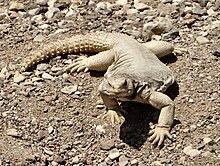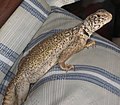Uromastyx
This article needs additional citations for verification. (July 2023) |
| Uromastyx[1] | |
|---|---|

| |
| Egyptian spiny-tailed lizard (Uromastyx aegyptia) | |
| Scientific classification | |
| Domain: | Eukaryota |
| Kingdom: | Animalia |
| Phylum: | Chordata |
| Class: | Reptilia |
| Order: | Squamata |
| Suborder: | Iguania |
| Family: | Agamidae |
| Subfamily: | Uromasticinae |
| Genus: | Uromastyx Merrem, 1820 |
| Species | |
|
See text | |
| Synonyms | |
|
Jeddaherdan | |
Uromastyx is a genus of African and Middle East or West Asian lizards in the family Agamidae. Member species are commonly called spiny-tailed lizards, uromastyces, mastigures, or dabb lizards.
Lizards in the genus Uromastyx are primarily herbivorous, but occasionally eat insects and other small animals, especially young lizards. They spend most of their waking hours basking in the sun, hiding in underground chambers at night time or when danger appears. They tend to establish themselves in hilly, rocky areas with good shelter and accessible vegetation.
Taxonomy
[edit]The generic name Uromastyx is derived from the Ancient Greek words ourá (οὐρά) meaning "tail" and -mastix (μάστιξ) meaning "whip" or "scourge", after the thick-spiked tail characteristic of all Uromastyx species.[2]
Species
[edit]The following species are in the genus Uromastyx.[3] Three additional species were formerly placed in this genus, but have been moved to their own genus, Saara.[3][4]
| Image | Scientific Name | Common Name | Distribution |
|---|---|---|---|
 |
Uromastyx acanthinura Bell, 1825 |
North African mastigure, North African spiny-tailed lizard | Morocco, Algeria, Tunisia, Libya, Egypt, Western Sahara, Chad, Mali, Niger, and Sudan |
 |
Uromastyx aegyptia (Forskål, 1775) |
Egyptian mastigure, Egyptian spiny-tailed lizard | Egypt and the Middle East. |
| Uromastyx alfredschmidti Wilms & Böhme, 2001 |
ebony mastigure, Schmidt's mastigure, Schmidt's spiny-tailed lizard | Algeria and Libya. | |
 |
Uromastyx benti (J. Anderson, 1894) |
Bent's mastigure, Yemeni spiny-tailed lizard | Oman and Yemen. |
 |
Uromastyx dispar Heyden, 1827 |
Sudan mastigure | Mauritania, Sudan, Chad, Western Sahara, Algeria, and Mali. |
 |
Uromastyx geyri (L. Müller, 1922) |
Geyr's dabb lizard, Geyr's spiny-tailed lizard, Sahara mastigure, Saharan spiny-tailed lizard, Saharan yellow uromastyx, yellow Niger uromastyx | Algeria, Mali, and Niger. |
| Uromastyx macfadyeni H. Parker, 1932 |
Macfadyen's mastigure[5] | Somalia | |
 |
Uromastyx nigriventris Rothschild & Hartert, 1912 |
Moroccan spiny-tailed lizard | Morocco and Algeria. |
| Uromastyx occidentalis Mateo, Geniez, López-Jurado & Bons, 1999 |
Western Sahara | ||
 |
Uromastyx ocellata Lichtenstein, 1823 |
ocellated spinytail, eyed dabb lizard, ocellated uromastyx | southern Egypt, Sudan, Eritrea, Djibouti, Ethiopia (near the Somali border), and northwestern Somalia |
 |
Uromastyx ornata Heyden, 1827 |
ornate mastigure | Egypt, Israel, Saudi Arabia, and Yemen |
 |
Uromastyx princeps O’Shaughnessy, 1880 |
princely spiny-tailed lizard, princely mastigure, Somalian mastigure | Somalia, Ethiopia |
| Uromastyx shobraki Wilms & Schmitz, 2007 |
Yemen | ||
 |
Uromastyx thomasi H. Parker, 1930 |
Omani spiny-tailed lizard, Thomas's mastigure | Oman |
| Uromastyx yemenensis Wilms & Schmitz, 2007 |
South Arabian spiny-tailed lizard | Yemen |
Nota bene: A binomial authority in parentheses indicates that the species was originally described in a genus other than Uromastyx.
Description
[edit]Uromastyx species range in size from 25 cm (10 in) for U. macfadyeni to 91 cm (36 in) or more for U. aegyptia. Hatchlings or neonates are usually no more than 7–10 cm (3–4 in) in length.[citation needed] Like many reptiles, these lizards' colors change according to the temperature and season.[6] During cool weather they appear dull and dark, but the colors become lighter in warm weather, especially when basking. The darker pigmentation allows their skin to absorb sunlight more effectively.
Their spiked tail is muscular and heavy, and is able to be swung at an attacker with great velocity, usually accompanied by hissing and an open-mouthed display of (small) teeth.[7] Uromastyx generally sleep in their burrows with their tails closest to the opening, in order to thwart intruders.[7]
Distribution
[edit]Uromastyx inhabit a range stretching through most of North and Northeast Africa, the Middle East, ranging as far east as Iran. Species found further east are now placed in the genus Saara.[4] Uromastyx occur at elevations from sea level to well over 900 m (3,000 ft). They are regularly eaten, and sold in produce markets, by local peoples.
Diet
[edit]Uromastyx lizards acquire most of the water they need from the vegetation they ingest.[citation needed] In the wild they generally eat any surrounding vegetation. When hatching, baby Uromastyx eat their own mother's feces as their first meal before heading off to find a more sustainable food source. They do this to establish a proper gut flora, essential for digesting the plants that they eat.
In the wild, adult U. dispar maliensis have been reported to eat insects at certain times of the year, when it is hot and their only food source available would be insects.[citation needed]
Reproduction
[edit]A female Uromastyx can lay anywhere from 5 to 40 eggs, depending on age and species. Eggs are laid approximately 30 days following copulation with an incubation time of 70–80 days.[8] The neonates weigh 4–6 g (0.14–0.21 oz) and are about 5 cm (2 in) snout to vent length.[8] They rapidly gain weight during the first few weeks following hatching.[8]
A field study in Algeria concluded that Moroccan spiny-tailed lizards add approximately 5 cm (2 in) of total growth each year until around the age of 8–9 years.[8]
Wild female Uromastyx are smaller and less colorful than males. For example, U. dispar maliensis females are often light tan with black dorsal spots, while males are mostly bright yellow with mottled black markings. Females also tend to have shorter claws.[citation needed] In captivity female U. dispar maliensis tend to mimic males in color.[9] U. dispar maliensis are, therefore, reputably difficult to breed in captivity.
Relationship with humans
[edit]
Captivity
[edit]Uromastyx are removed from the wild in an unregulated manner for the pet and medicinal trade in Morocco, despite their protected status in the country; conditions of the animals while being sold is often extremely poor and overcrowding is common.[10] Historically, captive Uromastyx had a poor survival rate, due to a lack of understanding of their dietary and environmental needs.[citation needed] In recent years, knowledge has significantly increased, and appropriate diet and care has led to survival rates and longevity approaching and perhaps surpassing those in the wild.[citation needed] With good care, they are capable of living for over 25 years, and possibly as old as 60.
Consumption by humans
[edit]U. dispar maliensis, known as "ḍabb" (Arabic: ضَـبْ) by peninsular Arabs, is historically consumed as food by some of the Bedouin population of the Arabian peninsula, mainly those residing in the interior and eastern regions of Arabia.[11][12][13][14] This lizard used to be considered an "Arabian delicacy".[15] It is recorded that when an Uromastyx was brought to the Islamic prophet Muhammad by Bedouins, Muhammad did not eat the lizard, but Muslims were not prohibited by him from consuming it; thus Muhammad's companion Khalid bin Walid consumed the lizard.[16][17][18][19]
In Judaism, this lizard is traditionally identified as the biblical tzav, one of the eight "creeping" animals forbidden for consumption that impart ritual impurity. The Torah states: “The following shall be impure for you among the creeping animals that swarm upon the earth: The weasel, and the mouse, and the dab lizard (tzav) of every variety; and the gecko, and the land-crocodile, and the lizard, and the skink, and the chameleon” (Leviticus 11:29-30).[20]
See also
[edit]References
[edit]- ^ "Uromastyx ". Integrated Taxonomic Information System.
- ^ "Oxford English Dictionary, uroˈmastix, n." Oxford English Dictionary. Retrieved 16 June 2016.
- ^ a b Genus Uromastyx at The Reptile Database. www.reptile-database.org.
- ^ a b Wilms TM, Böhme W, Wagner P, Lutzmann N, Schmitz A (2009). "On the Phylogeny and Taxonomy of the Genus Uromastyx Merrem, 1820 (Reptilia: Squamata: Agamidae: Uromastycinae) – Resurrection of the Genus Saara Gray, 1845". Bonner zoologische Beiträge 56 (1/2): 55–99.
- ^ Beolens, Bo; Watkins, Michael; Grayson, Michael (2011). The Eponym Dictionary of Reptiles. Baltimore: Johns Hopkins University Press. xiii + 296 pp. ISBN 978-1-4214-0135-5. (Uromastyx macfdyeni, p. 164).
- ^ Robert, Nigel. "10 Types of Uromastyx Species". MoreReptiles. Retrieved 2022-07-22.
- ^ a b Capula, Massimo; Behler, John L. (1989). Simon & Schuster's Guide to Reptiles and Amphibians of the World. New York: Simon & Schuster. p. 259. ISBN 0-671-69098-1.
- ^ a b c d Vernet, Roland; Lemire, Michel; Grenot, Claude J.; Francaz, Jean-Marc (1988). "Ecophysiological comparisons between two large Saharan Lizards, Uromastyx acanthinurus (Agamidae) and Varanus griseus (Varanidae)". Journal of Arid Environments 14:187–200.
- ^ "Deer Fern Farms Mali Uromastyx Page". Deerfernfarms.com. 2009-01-13. Archived from the original on 2009-08-27. Retrieved 2016-01-07.
- ^ Bergin, Daniel; Nijman, Vincent (2014-11-04). "Open, Unregulated Trade in Wildlife in Morocco's Markets (PDF Download Available)". Researchgate.net. Retrieved 2016-01-07.
- ^ "Hunting 'dabb' in Al-Asyah". Arab News. 2001-04-27. Retrieved 2016-01-07.
- ^ "Saudi Aramco World: The Toad-Head from Najd And Other Reptiles". Archive.aramcoworld.com. Retrieved 2016-01-07.
- ^ American Bedu (September 26, 2008). "Don't Know What to Cook? How About Dhub – Traditional Saudi Beudion Dish". American Bedu.
- ^ Usman, Omar (July 10, 2008). "Sunnah of the Dhab Lizard Delicacy". Muslim Matters.
- ^ John P. Rafferty (January 2011). Deserts and Steppes. The Rosen Publishing Group. pp. 55–. ISBN 978-1-61530-317-5.
- ^ "SahihMuslim.Com". SahihMuslim.Com. Retrieved 2016-01-07.
- ^ IslamKotob (1978). Sahih Muslim: Being Traditions of the Sayings and Doings of the Prophet Muhammad as Narrated by His Companions and Compiled Under the Title Al-Jami'-us-sahih : with Explanatory Notes and Brief Biographical Sketches of Major Narrators. Islamic Books. pp. 1242–. GGKEY:A3373925T9E.
- ^ "Quran / Hadith English Translation - Search Engine". Religeo.com. Archived from the original on 2015-12-24. Retrieved 2016-01-07.
- ^ "Ruling on Different Types of Lizards". ImamFaisal.com. 2011-10-27. Retrieved 2016-01-07.
- ^ "The Aleph Society- Let My People Know". 18 January 2013.
